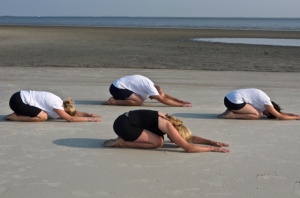
Inside Yoga 304 (24/6/2020)
As we continue to live under the restrictions of the Covid-19 pandemic, we are most likely feeling stressed not just in mind but also body, suffering from fatigue and all that goes with this unusual existence. And with it, the need to get the most out of our yoga practice. There are three words which sum up an approach to practice that brings maximum benefit: soften, settle and stretch.
When we practice a yoga posture, we might notice how tense we feel, or how difficult it can be to feel relaxed and released by the position. It might not be the posture in itself which is stopping us from finding what we seek from our practice but our approach.
If we approach yoga exercises (asanas) with the intention of getting to the destination at all costs – ie maximum stretch or exertion – as fast as possible, in yoga this is regarded as missing the point. Trying to force ourselves without paying attention to our breathing, our mind and our body simultaneously can mean that our attempts are counter-productive. And using this incorrect approach can lead to the feeling that it is not relaxing or nourishing, and at worst risking an injury.
The three words soften, settle and stretch asks us to first allow ourselves to settle into a position by paying attention, first, to our breathing. If we are forcing too much our breathing will be adversely affected, huffing and puffing, or perhaps gasping each breath as we struggle. As we move into a posture we aim to pay attention to our breathing (which needs to be slow and full) plus, what our body is telling us. Our body is effective at giving warnings to negative activity. Paying attention and responding appropriately is important. This approach applies to the swifter movements of a sun salutation as much as a more static seated asana.
Soften refers to how we avoid stressing our body by forcing it against its will, and instead, whether it is a simple or complex yoga asana (posture), we approach it by seeking to soften first. For example, when in a position our muscles are in a combination of flexion, extension or passive. Learning to notice which ones do which is key to our yoga practice. An incorrect approach might have some muscles in flexion or extension when passive is the appropriate state. None need to be forced and all can soften.
Another way to explain soften is this. Imagine someone says to you, stop clenching your jaw. It is only at that point did we realise we were clenching and stressing our face. When we consciously soften we notice how much better our face feels. A simple act of self-awareness is all it takes.
Settle refers to how we allow time to get into position, to hold it effectively, whether it is a standing or seated position, we move into posture and do not rush. Even if we are practising a flowing sequence of asanas (postures) where we move to the next position after five breaths, there is always time to settle. And if holding longer, settling give us time to understand the position, to notice how we are right then, to be mindful of the moment, and get maximum benefit from the practice.
It could be said that the reason many of us enjoy our practice and feel the benefit by the end of a session is that we have employed the approach of soften and settle throughout, with each moment of soften and settle producing a morsel of benefit which becomes a large amount by the end.
Stretch, which is the word most associated with yoga exercises, comes last because it is only effective and beneficial if the previous two parts of soften and settle are employed during the practice.
See for yourself, while practising employ the approach of soften, settle and stretch.
Any questions or comments contact me via the blog reply panel below or email gary@yogabristol.co.uk
